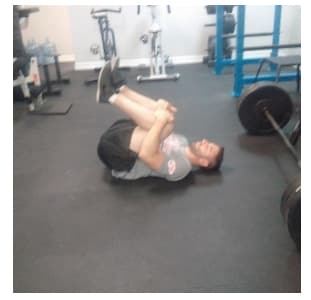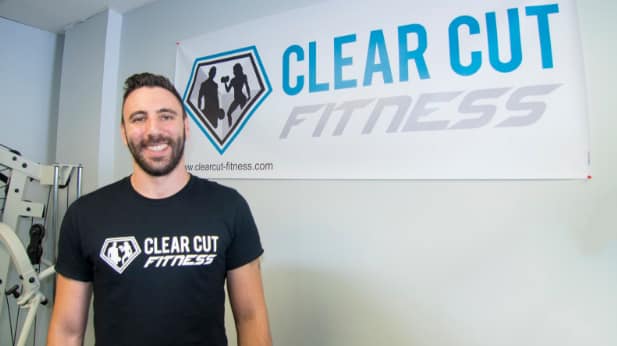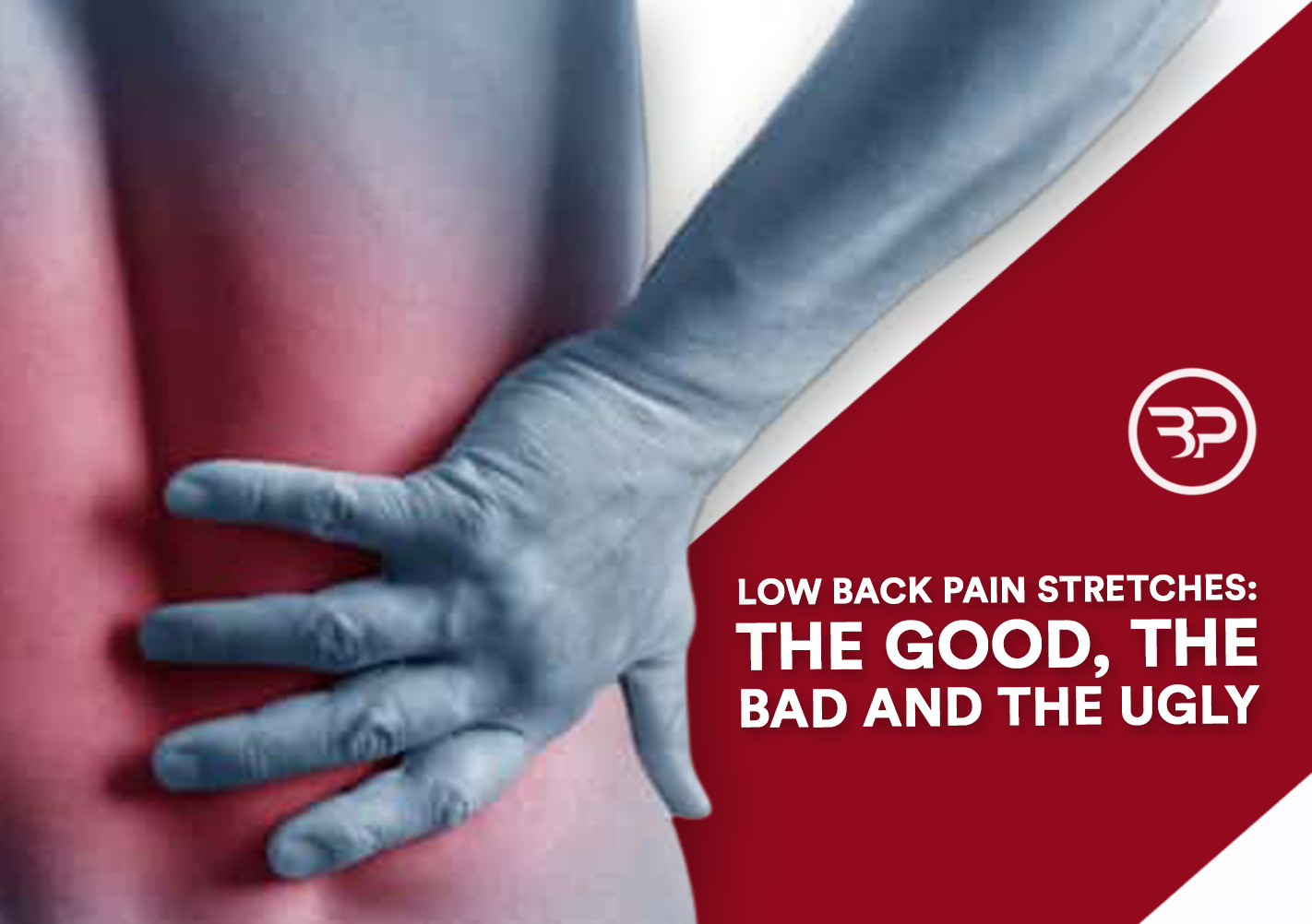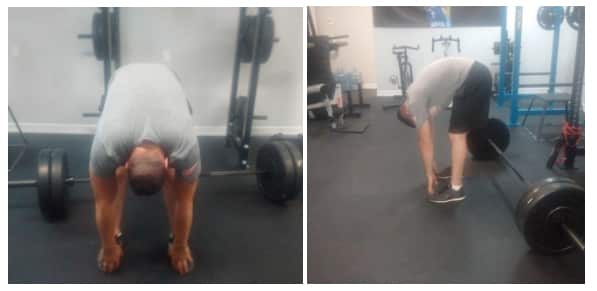Low Back Pain Stretches: The Good, The Bad and The Ugly
August 25, 2016
Guest Post By Chris Diamantakos
Low back pain is as common as it is brutal. No wonder so many people turn to low back stretches to relieve the pain. But here’s the sad truth:
The wrong stretches make a bad situation worse.
But the right stretches, done correctly, will help alleviate your pain. You’ll get back on track to looking better naked and pushing weight in the gym.
This article discusses what to avoid and what to try.
My Story And How It Can Help You
Low back pain is the Ben and Jerry’s of pain…minus the all the good parts. It comes in many different flavors and has many different causes. It can range from acute sharp pain in a specific area to a constant dull/nagging pain.
I know this all too well because I suffered a low back injury back in college. It left me in pain, weak as f@$% and unable to do many everyday tasks for about two months. Sometimes stretching would make it feel better, but the pain didn’t subside for good.
I did some serious research and found that what I needed didn’t involve stretching the low back at all. Six weeks after incorporating corrective exercise and the types of stretching described later in this article, I was pain free, playing hockey and lifting heavy, and making #gainz again. Now, I want the same for you.
Back pain is crippling. And if you’re in pain, it’s time to make a change.
Research suggests that stretching the low back can relieve pain for roughly 20 minutes.(1,2,3) So the relief is very short term. Not good if you’re overwhelmed with work. Performing the three stretches below stimulates the stretch receptors in your back to give you a false sense of pain relief. They should be avoided because they cause instability in your core. But you want the opposite: stability. That’s the key to a healthy and pain-free back.
Three Stretches To Avoid
- Toe Touches: Sure, they feel but, but you’re doing more harm than good. This stretch forces you to round your back and compress the posterior (back side) of your intervertebral discs, potentially aggravating a disk injury and making your pain worse.

- Pulling The Knee To The Chest: Pretty much the same deal as toe touches, but a slightly different targeted area of the back. Plus, it looks like you’re trying to fart. Again: not a proper solution to the problem.
- The Bench Slouch: Okay, this isn’t really a stretch, just another bad movement pattern to avoid. Posture matters. A lot. And both athletes and desk jockeys spend a lot of time sitting, leaning forward and wrecking their posture. Stay as upright as you can. If you slouch over, your low back will round and stretch. That stretch increases the pressure on the discs in your spine, exacerbating pain and injury while decreasing core stability. Obviously, this is a great way to take a step backwards in your battle of back-pain and decrease your strength in the gym. Sit tall, stay engaged, and avoid the bench slouch.
Three Stretches That Can Help Low Back Pain
First, an important caveat. Dr. Google is not a real doctor. And self-diagnosis is terrible idea. Only a visit to a doctor can determine what type of injury you have. Once diagnosed, you can work on a corrective exercise plan.
But you may find these stretches and exercises will help relieve and rehab your back.
- Glute Stretch and Hip Thrust
The glutes are a huge muscle group that plays an important role in preventing low back pain. They support the spine and distribute load so that the low back doesn’t take the brunt of your deadlifts. They also “externally rotate” or “outwardly rotate” your leg. When these muscles become chronically tight, or weak and inactive, the load of a weight shifts onto the lower back, leading to pain or injury and weakness in the gym.
Therefore, in the interest of getting strong and looking better naked, we need to attack your glutes.
Stretching the glutes is the first step. You’ll probably notice some blessed pain relieve that makes you think “really, that’s all I had to do? I instantly feel better.”
But the next and most important part is actually strengthening and activating those muscles. You want the muscles to support your back day in and day out.
One of my favourite glute exercises is the hip thrust. When the purpose is low back rehab, you want to pick a lighter weight and really make sure you can feel the glutes contracting throughout the movement. Perform it with a controlled tempo and squeeze your butt cheeks together like you’re holding cash. This improves mind-muscle connection for your glutes, improving strength, stability, and even muscle growth.
Tip: use real cash.
Second tip: Use that cash to pay for something you don’t enjoy ;).
Final note: trying to be explosive with these may be beneficial in an athletic performance setting, but not for focusing on muscle contractions. Slow and controlled in the name of the game with back pain.
2. Hip Flexor
Tight hip flexors can pull your pelvis into an aggressive anterior tilt. If hip flexors are really tight, you can look like you’ve got permanent stripper butt. Tight hip flexors can put pressure on the discs in the low back due to the hyperextended position, which pinches the disks themselves.
Stretching the hip flexors relieves the stress put on the low back, allowing the spine to be in a neutral position. You’ll notice that you’ll be much more upright and pain-free.
This is my favorite hip flexor stretch. Make sure that the movement and stretch is in the front from the top of your hip. It’s typical to see people overstretch and actually extend their lower back during this movement. Don’t worry about staying too upright. just make sure you feel the stretch from the front.
Just like the glutes, you’ve got to a put in a bit more work other than stretching. Tight hip flexors usually mean weak glutes and weak anterior core (abs.)
Focus on strengthening those and kiss your pain goodbye.
3. Lats
Tight lats and poor thoracic mobility (mid-upper back) can also mess with your low back. When you have weak thoracic mobility, your body will compensate by hyperextending the lower back during overhead exercises like pull-ups and overhead presses. Besides making lower back pain worse, poor t-spine mobility can open the door to shoulder injuries during overhead movements. Let’s avoid that, shall we?
Two Mobility Drills for Low Back Pain
These drills improve mobility by having the movement comes from your mid back. This ensures your low back is used for it’s intended purpose: stability.
- Foam Roll the Lats
The Lats are another huge muscle that runs from your upper arm (under your armpit) all the way down the back to the top of the hips. As you can see, I’m focusing on the mid-upper part of the muscle, from under the armpit to middle of the rib cage.
2. Rib Grabs
This exercise will help mobilize the spine so that the movement comes from the proper joints and not the lower back. When performing these, make sure you keep your hips square, core tight, and don’t allow any movement to come from the low back. Just focus on squeezing your shoulder blades into your spine, and following your hand with your head.
The Takeaway
Yeah, stretching feels good. But there is a difference between how something feels, and the physiological response in your body. It’s time to ditch the old classic back stretches and instead, focus on improving your hips, glutes, lats, and t-spine.
Add these exercises to your warm-up. You’ll be pain-free and on your way to improved gains and injury-free training.
References
- McGill, S (2007) Low Back Disorders
- McGill, S (2014) Ultimate Back and Fitness Performance
- Kell, R. T., & Asmundson, G. J. (2009). A comparison of two forms of periodized exercise rehabilitation programs in the management of chronic nonspecific low-back pain. The Journal of Strength & Conditioning Research,23(2), 513-523.
About The Author

Chris Diamantakos is a personal trainer, nutrition coach and owner of Clear Cut Fitness in Toronto, Canada. He works on low back pain issues with anyone from postpartum women to NHL athletes. His personal website is www.chrisdiamantakos.com
[sc name=”Fat Loss”]










Hey man dig the article! Have you ever looked into Jefferson curls or squat holds for relieving back pain?
Thanks!
Austin
Sorry, but do not understand this kind of generalization in articles writen by people who should act like a professional. There are many different reasons for low back pain, from simple hernia to spondylolisthesis, etc., and lot of them require diff. stretch and exercisee therapy. For some of them like L5-S1 spondylolisthesis pulling knees to chest are giving good pain relief.
You’re absolutely right. There are more specific ways to treat a low back injury once you find out exactly what the issue is. Stuart McGill actually mentions that misdiagnosis is very common. He also outlines the importance of creating spinal stability/stiffness while improving mobility in other joints like the shoulders and hips. This is why I wrote about mobilizing each joint. Here is my experience. Anyone I work with (whether it be an office worker or a pro athlete) who suffers from low back pain also suffers from poor mobility somewhere. So these are important no matter what the diagnosis is. This is what the article focuses on.
I’ve also noticed that the different causes of low back pain have many of the same factors in corrective rehab. These include core activation/strength/endurance and joint mobility. I’ve only found more of a difference in “extension vs flexion” back pain. There are different exercises and stretches depending on which movement causes the pain.
You’re also right about pulling the knees to chest. It CAN give you pain relieve. But as I mentioned in the article, the relief is temporary.
I can’t stress enough how important it is to be properly diagnosed before starting or creating a specific corrective exercise plan. I mentioned that as well.
Thanks for your insight.
[…] Low Back Pain Stretches: The Good, Bad, and Ugly […]
[…] August 25, 2016 […]